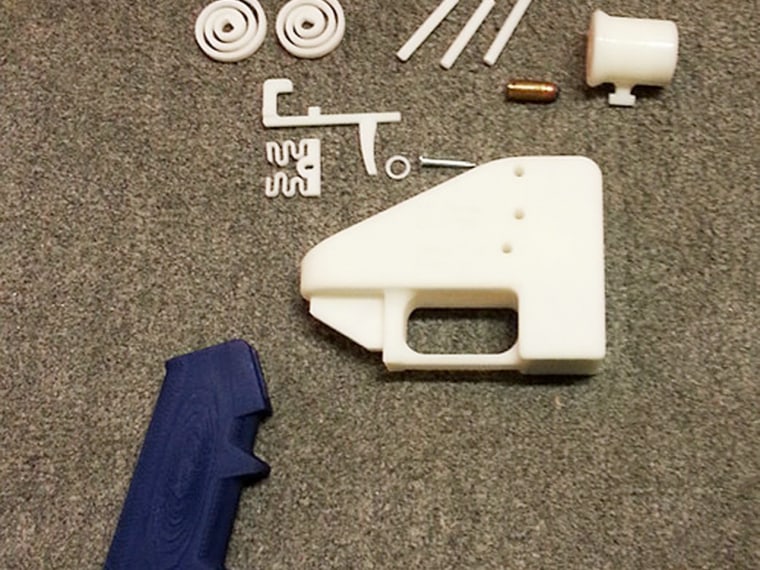
New software has been developed that aims to restrict the manufacture of firearms that have been created using new 3-D technology.
The world's first gun made using 3-D printing — called "The Liberator" — was successfully fired on May 6 in Austin, Texas. In just three days the blueprint created by startup Defense Distributed to produce the plastic gun had been downloaded around 100,000 times, according to Forbes Magazine.
Anti-gun campaigners have criticized the project, whilst lawmakers in different U.S. states have moved to pass new legislation to prohibit the manufacture, sale and use of the digitally made firearms. And now Danish startup Create It REAL has produced software that it says blocks users from printing guns in the first place.
"The likely buyers are 3-D printer manufacturers who want to minimize their liability risk and offer a firearm parental control feature to their customers," Create It REAL's CEO Jeremie Pierre Gay told CNBC.
(Read More: 3-D-printed AR-15s aimed at gun control)
"The feature creates a unique digital fingerprint of the firearm ... the manufacturer could decide to block the print or to simply give a warning to the user of the potential danger."
The software has taken a year to develop. The firm realized there was a gap in the market after surveying end users and 3-D printer manufacturers. Gay told CNBC that his previous job working with Digital Rights Management (DRM) for technology firm Motorola served him well.
"[We realized] people are interested in the ability to put a lock on their firearms at home, the same should be possible on a 3-D printer as a parental control feature. I would say that this feature is customer driven even if they did not know they wanted the feature when we asked," he said.
"The possibility to make a firearm at home is not new, there are many plans on how to do it on Internet, the problem with 3-D printing is that it could become simply too easy, this feature makes it more complicated again."
Cody Wilson, the man behind nonprofit Defense Distributed was skeptical that the product would actually be able to prohibit the printing of guns, which are produced as separate parts and then assembled. "The Liberator" is printed with hard plastic and fires a standard .380 caliber bullet. The only non-printed piece is a common hardware store nail which is used as its firing pin.
(Read More: DIY Weapons: Start-Up Aims to Grow 3-D Gun Printing)
"Such software must walk a very fine line, of which I've no doubt it is incapable...It's interesting PR to the uninitiated only," the 25-year-old law student at the University of Texas told CNBC.
"'The Liberator' pistol is an assembly of over 17 parts, most of which individually would not set off a detection software unless the exact model was blacklisted. Think about it, springs, hammer, even the grip. These are not 'guns'."
'Wild West' Regulation
Both New York City and New York State have introduced legislation to curb the making of 3-D printed firearms or ban their use altogether and similar bills have been introduced in California. Linda Rosenthal, a New York State assembly member told CNBC that New York's bill is currently sitting with the Codes Committee after the legislative session ended on June 21.
"I have all intentions of pursuing this legislation next session," she told CNBC. "The controversy surrounding the passage of the SAFE ACT (the New York Secure Ammunition and Firearms Enforcement Act) will make passing any piece of gun-related legislation that much more difficult, but I think this is a very important issue that must be addressed before the technology becomes widely available."
New York State should act as a leader to provide a national model for other states to follow, Rosenthal said, and welcomes the new software that she says is effectively the industry regulating its own behavior.
(Read More: How 3-D printers are reshaping medicine)
First 3-D-Printed Gun Fires ShotThe first shot has been fired from a gun made by a 3-D printer. NY Sen. Chuck Schumer said gun printing should be crime.
"It is important that industry and government partner with each other to address this issue. Neither acting alone will be able to accomplish enough to deter dangerous behavior....Given that no technology is foolproof, it is critical that the states have strong tools available to discourage wrongdoing and criminalize bad behavior," she told CNBC.
"3-D printing is a very new technology, and in terms of regulation, it is the Wild West out there."
Despite the issues surrounding the manufacture of firearms, 3-D printing — creating three-dimensional solid objects from digital models — is gathering momentum and is transforming everything from medicine to home goods. Printers that once cost $30,000 now are priced closer to $1,000 and have the potential to rewrite the rules of global manufacturing.
The market for 3-D printing was estimated at about $1.7 billion in 2011 and could hit $6.5 billion by 2019, according to research firm Wohlers Associates.
By CNBC.com's Matt Clinch; Follow him on Twitter @mattclinch81
